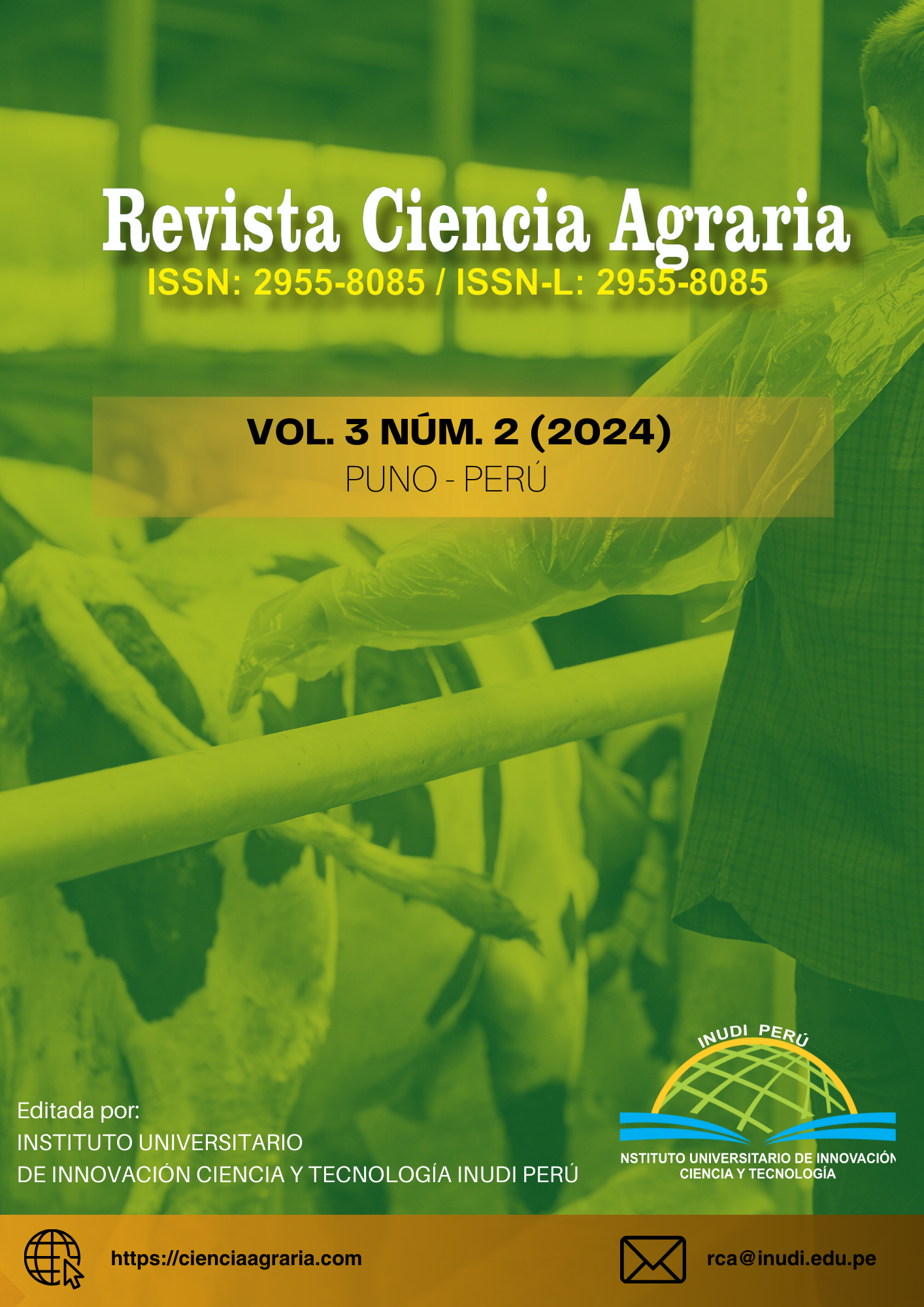Determination of a multiple linear regression model for the prediction of Pol in sugarcane (Saccharum officinarum)
DOI:
https://doi.org/10.35622/Keywords:
agroindustry, efficiency, optimization, production, qualityAbstract
In the sugar manufacturing process, Pol in cane is a quality parameter. However, there is a problem in its determination, since it is conditioned by the complexity of the calculation, which forced this research to be carried out to provide a feasible, dynamic and economical solution. The objective was to develop a predictive model that allows predicting Pol in cane more quickly and easily from six independent variables: brix in juice, Pol in juice, non-Pol in juice, purity of juice, fiber in cane and cane juice. The research was quantitative with an explanatory and transversal design, where data collected during the 2023-2024 harvest at a sugar mill in the southern region of Guatemala was available. 23,470 records were analyzed for each variable. The results of the multiple linear regression analysis demonstrated that the variables Pol in juice and fiber in cane directly affect the prediction of Pol in cane by evidencing standardized coefficients with statistical significance. A solid mathematical model was generated that attributes high explanatory capacity to the variables Pol in juice and fiber in cane. The formula equation is: Pol in cane = 3.642 + (0.80 x Pol in juice) – (0.242 x fiber in cane). It is concluded that the new proposal for calculating Pol in cane establishes a balance between its simplicity and precision, will facilitate its application and will positively impact decision-making in sugar production.
References
Bastidas, L., De Sousa, O., Briceño, R., & Hernández, E. (2009). Potencial azucarero y panelero de cinco cultivares de caña de azúcar en el Valle de Santa Cruz de Bucaral, Estado Falcón, Venezuela. Agronomía Tropical, 59(2), 137-148.
Cavalcante, C. S., & de Albuquerque, F. M. (2015). The Sugar Production Process. In F. Santos, A. Borém & C. Caldas (Eds.), Sugarcane: Agricultural Production, Bioenergy and Ethanol (pp. 285–310). Elsevier Inc. https://doi.org/10.1016/B978-0-12-802239-9.00014-1
Chauhan, M. K., Chaudhary, S., & Kumar, S. (2011). Life cycle assessment of sugar industry: A review. Renewable and Sustainable Energy Reviews, 15(7), 3445-3453. https://doi.org/10.1016/j.rser.2011.04.033
Chiatrakul, J., Terdwongworakul, A., Phuangsombut, K., & Phuangsombut, A. (2022). Improved evaluation of commercial cane sugar content in sugarcane stalk using near infrared hyperspectral imaging and stalk axis rotation technique. Biosystems Engineering, 223, 161-173. https://doi.org/10.1016/J.BIOSYSTEMSENG.2022.08.019
Corrêdo, L. P., Wei, M. C., Ferraz, M. N., & Molin, J. P. (2021). Near-infrared spectroscopy as a tool for monitoring the spatial variability of sugarcane quality in the fields. Biosystems Engineering, 206, 150-161. https://doi.org/10.1016/j.biosystemseng.2021.04.001
Da Costa, M. V. A., Fontes, C. H., Carvalho, G., & Júnior, E. C. de M. (2021). Ultrabrix: A device for measuring the soluble solids content in sugarcane. Sustainability, 13(3), 1227. https://doi.org/10.3390/su13031227
De Almeida Silva, M., Véliz, J. G. E., Sartori, M. M. P., & Santos, H. L. (2022). Glyphosate applied at a hormetic dose improves ripening without impairing sugarcane productivity and ratoon sprouting. Science of the Total Environment, 806, 150503. https://doi.org/ 10.1016/j.scitotenv.2021.150503
Díaz Narváez, V. P. (2009). Metodología de la investigación científica y bioestadística para profesionales y estudiantes de las ciencias de la salud (1ª ed.). Editorial Universidad Evangélica de El Salvador.
Drezner, Z., & Turel, O. (2011). Normalizing variables with too-frequent values using a Kolmogorov–Smirnov test: A practical approach. Computers & Industrial Engineering, 61(4), 1240-1244. https://doi.org/10.1016/J.CIE.2011.07.015
Eggleston, G. (2002). Deterioration of cane juice—sources and indicators. Food chemistry, 78(1), 95-103. https://doi.org/10.1016/S0308-8146(01)00390-9
Eggleston, G., & Lima, I. (2015). Sustainability issues and opportunities in the sugar and sugar-bioproduct industries. Sustainability, 7(9), 12209-12235. https://doi.org/10.3390/su70912209
Guimarães, C. C., Assis, C., Simeone, M. L. F., & Sena, M. M. (2016). Use of near-infrared spectroscopy, partial least-squares, and ordered predictors selection to predict four quality parameters of sweet sorghum juice used to produce bioethanol. Energy & fuels, 30(5), 4137-4144. https://doi.org/10.1021/acs.energyfuels.6b00408
Hernández Sampieri, R., Fernández Collado, C., & Baptista Lucio, P. (2014). Metodología de la Investigación (6ª ed.). Mc Graw Hill Education.
Islam, M. S., Pan, Y. B., Lomax, L., & Grisham, M. P. (2021). Identification of quantitative trait loci (QTL) controlling fibre content of sugarcane (Saccharum hybrids spp.). Plant Breeding, 140(2), 360-366. https://doi.org/10.1111/pbr.12912
Jackson, P. A. (2005). Breeding for improved sugar content in sugarcane. Field Crops Research, 92(2-3), 277-290. https://doi.org/10.1016/J.FCR.2005.01.024
Lanza, J. G., Churión, P. C., & Gómez, N. (2016). Comparison between Kjeldahl traditional method and automated Dumas (N cube) method for determination of proteins in several kinds of food. Saber, 28(2), 245-249. https://www.redalyc.org/articulo.oa?id=427749623006
Lejars, C., Auzoux, S., Siegmund, B., & Letourmy, P. (2010). Implementing sugarcane quality-based payment systems using a decision support system. Computers and Electronics in Agriculture, 70(1), 225–233. https://doi.org/10.1016/J.COMPAG.2009.10.010
Li, Z., Gao, X., & Lu, D. (2021). Correlation analysis and statistical assessment of early hydration characteristics and compressive strength for multi-composite cement paste. Construction and Building Materials, 310, 125260. https://doi.org/10.1016/j.conbuildmat.2021.125260
Lumley, T., Diehr, P., Emerson, S., & Chen, L. (2002). The importance of the normality assumption in large public health data sets. Annual review of public health, 23(1), 151-169. https://doi.org/10.1146/annurev.publhealth.23.100901.140546
Phuphaphud, A., Saengprachatanarug, K., Posom, J., Maraphum, K., & Taira, E. (2020). Non-destructive and rapid measurement of sugar content in growing cane stalks for breeding programmes using visible-near infrared spectroscopy. Biosystems Engineering, 197, 76-90. https://doi.org/10.1016/j.biosystemseng.2020.06.012
Plaza-Diaz, J., & Gil, A. (2015). Sucrose: Dietary Importance. In B. Caballero, P. M. Finglas & F. Toldrá (Eds.), Encyclopedia of Food and Health (pp. 199–204). Elsevier Ltd. https://doi.org/10.1016/B978-0-12-384947-2.00668-1
Reyes-Hernández, J., Torres-de los Santos, R., Hernández-Torres, H., Hernández-Robledo, V., Alvarado-Ramírez, E., & Joaquín-Cancino, S. (2022). Rendimiento y calidad de siete variedades de caña de azúcar en El Mante, Tamaulipas. Revista Mexicana De Ciencias Agrícolas, 13(5), 883–892. https://doi.org/10.29312/remexca.v13i5.3232
Robertson, M. J., & Donaldson, R. A. (1998). Changes in the components of cane and sucrose yield in response to drying-off of sugarcane before harvest. Field Crops Research, 55(3), 201–208. https://doi.org/10.1016/S0378-4290(97)00065-8
Sajid, M., Amjid, M., Munir, H., Valipour, M., Rasul, F., Khil, A., Alqahtani, M. D., Ahmad, M., Zulfiqar, U., Iqbal, R., Ali, M. F., & Ibtahaj, I. (2023). Enhancing sugarcane yield and sugar quality through optimal application of polymer-coated single super phosphate and irrigation management. Plants, 12(19), 3432. https://doi.org/10.3390/plants12193432
Salgado, S., Núñez, R., J Peña, J., Etchevers, J. D., Palma, D. J., & Soto, R. M. (2003). Manejo de la fertilización en el rendimiento, calidad del jugo y actividad de invertasas en caña de azúcar. Interciencia, 28(10), 576-580. https://www.redalyc.org/articulo.oa?id=33908503
Sawada, T. (2021). Conditions of the central-limit theorem are rarely satisfied in empirical psychological studies. Frontiers in Psychology, 12, 762418. https://doi.org/10.3389/fpsyg.2021.762418
Schmidt, A. F., & Finan, C. (2018). Linear regression and the normality assumption. Journal of clinical epidemiology, 98, 146-151. https://doi.org/10.1016/j.jclinepi.2017.12.006
Serrano Febles, J., Luis León, M., & Luis Orozco, J. (2022). Análisis de la situación operacional de la etapa de extracción de un Central azucarero. Ingeniería y Desarrollo, 40(2), 114–130. https://doi.org/10.14482/inde.40.02.624.749
Sorol, N., Zossi, S., Juarez, B., Diez, P., Medina, S., & Ruiz, M. (2021). Espectroscopía NIRS en el estudio de calidad de caña de azúcar Parte I: Correlaciones para Brix, Pol, Sacarosa, Glucosa y Fructosa. Revista industrial y agrícola de Tucumán, 98(1), 61-66.
Waclawovsky, A. J., Sato, P. M., Lembke, C. G., Moore, P. H., & Souza, G. M. (2010). Sugarcane for bioenergy production: an assessment of yield and regulation of sucrose content. Plant biotechnology journal, 8(3), 263-276. https://doi.org/10.1111/j.1467-7652.2009.00491.x
Downloads
Published
Issue
Section
License
Copyright (c) 2024 Flavio Reyes, Estuardo Monroy (Autor/a)

This work is licensed under a Creative Commons Attribution 4.0 International License.











